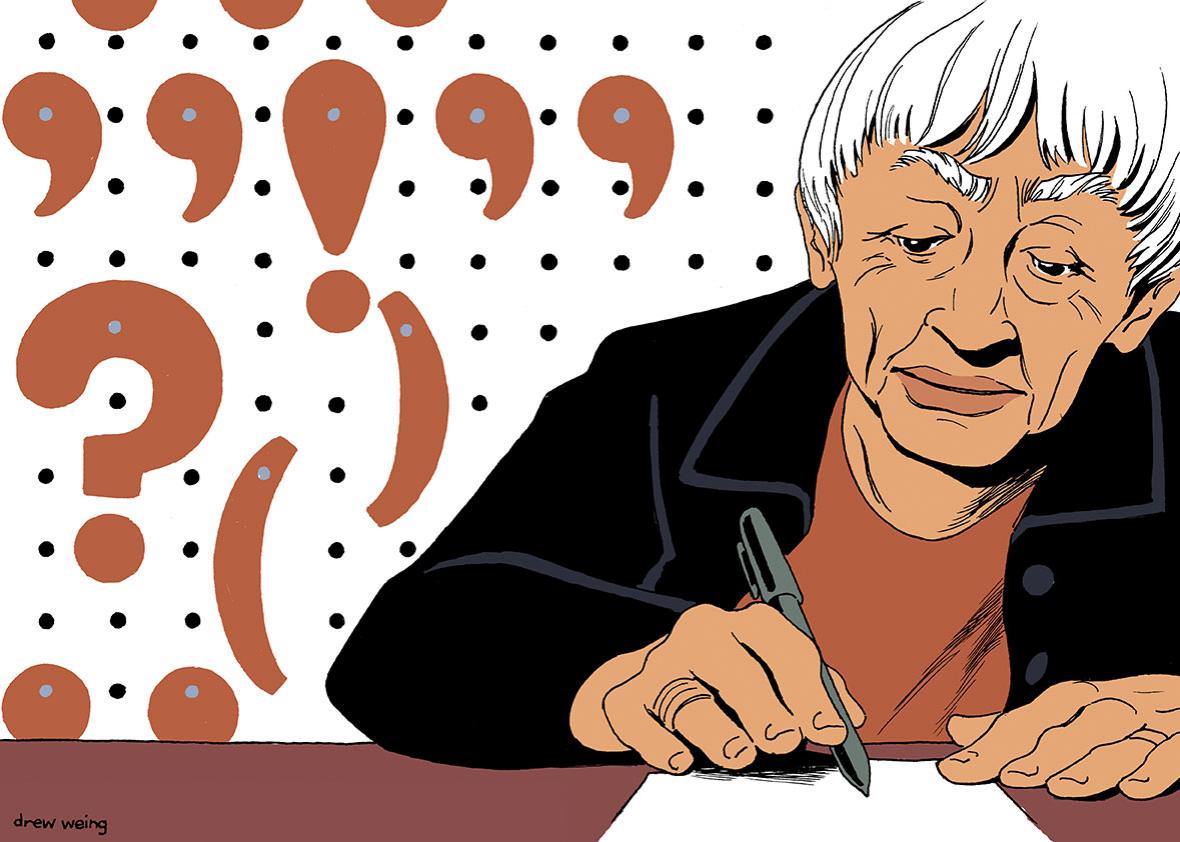The first thing you learn when you set out to teach writing is that you will never teach anyone to write well. It’s a cruel joke universities play on humanities grad students. As you’re preparing to step into a classroom, they assign you an impossible task, one they cloak with a label like “Introduction to Rhetoric” or “Expository Composition.” Here are 20 undergraduates, they say. Show them how to make their prose sing. Staring your new charges down, you begin to speak. Your voice cracks. They see the fear in your eyes.
In this light, there’s something almost pathetic about most writing manuals, whether they’re taken up as pedagogical tools or personal aids. Flickering candles in dimly lit rooms, they offer little assistance to those who are truly in the dark.
This is the danger that looms over Ursula K. Le Guin’s Steering the Craft. A marvelous writer, Le Guin has always been attentive to the minutest details of her own prose. In her fantasy novel A Wizard of Earthsea, for example, she relies heavily on words with Germanic roots to convey the rawness of her windswept world. Attempting to help others write with similar skill, however, she too must reckon with the insurmountability of her task.
Based on workshops that Le Guin began teaching to “writers of narrative prose” almost 20 years ago, Steering the Craft—substantially updated from its 1998 edition—bills itself as “a 21st-Century guide to sailing the sea of story.” It hedges its bets from the first pages of its introduction, insisting “it is not a book for beginners.” Make it past that initial warning, and you’ll soon discover that it modestly aims “to clarify and intensify your awareness of certain elements of prose writing and certain techniques and modes of storytelling.” Whatever else it offers, it will not teach you how to write.
It may, however, help you unlearn the lessons of those who’ve taught you poorly. Le Guin repeatedly inveighs against “fake rules”: wonky, almost inexplicable principles such as the idea that sentences shouldn’t begin with the construction “There is.” Such arbitrary dictates are, of course, the creations of those who’ve found it impossible to teach writing but been obliged to try anyway. I’ve been there during my own time in the classroom, found myself offering shortcuts in place of systems. Fake rules are testaments to pedagogical failure, but at least they give you the feeling that you’re imparting something, however false.
Nodding to such encounters with the impracticable, Le Guin tends to offer rationales before she proposes rules of her own, and these rationales soon give way to something larger. “The important thing for a writer,” she proposes, is “to know what you’re doing with your language and why.” Unpacking that why often means appealing to deeper principles, leaving writing as such beholden to some higher cause. Thus, for example, she asserts that it is “a writer’s moral duty … to use language thoughtfully and well.” She’s not speaking here of mere correctness, but of clarity, of the work we put in to ensuring others will know what we mean. And she makes one point clear enough: You don’t need to agree with the exact reasons she offers, she just wants to ensure that you have some of your own.
Ultimately, Steering the Craft elevates storytelling above all other values. Setting it in opposition to simply “giving information [or] explaining,” the goals of “most writing classes … in school or college,” Le Guin declares it the first principle of almost all prose. “The chief duty of a narrative sentence,” she writes, “is to keep the story going.”
In Le Guin’s hands, this commitment to narrative drive grounds critical judgments as much as it does a writer’s choices. Sometimes it simply serves to explicate her other dictates, as when she explains that changing verb tense too often interrupts the flow of a story, pulling the reader out of its spell. Elaborating on this obligation to keep the tale turning, she writes, “You are the Pied Piper, your sentences are the tune you play, and your readers are the children of Hamelin (or, if you prefer, the rats).” Every choice a writer makes, she implies at such moments, should be a choice in the service of story, not of some arbitrary rule.
Le Guin’s focus on story inspires some idiosyncratic observations. Poetry, she claims, can get away with stopping readers in their tracks, asking them to admire the elegance of its constructions. By contrast, prose (narrative prose, at any rate) cannot do so without sacrificing some key component of itself. Transforming this distinction into a critical guideline, Le Guin reads the work of other writers accordingly. While “many people admire the elaborate, ornate prose of writers such as Nabokov,” she claims that she finds such language “difficult to get through because it’s always stopping to be admired.”
If Nabokov demands that his readers pause, Le Guin’s critique of him invites similar—if subtler—inspection. Here it’s Nabokov’s language that acts, Nabokov’s prose that is “always stopping to be admired.” Contagious, that action, the action of stopping, causes its readers to stop as well, removing them from the story in the process. But even when it inspires inaction, prose is active, always moving, whether or not it is, as Le Guin says it should, moving on.
In theorizing a necessary link between writing and storytelling, Le Guin characterizes the best kinds of writing as vital creatures that have something to say about vitality. Discussing how readers should approach the book’s many writing exercises, Le Guin instructs them to “make each exercise not a static scene but the account of an act or action, something happening.” To illustrate this point, and all those it subsumes, Le Guin structures her book’s 10 chapters around exemplary passages—drawn variously from the work of Rudyard Kipling, Charles Dickens, Virginia Woolf, and more. Above all else, these excerpts are reminders that writing is never its own end; it always exists to be read, its own actions engendering others, movements carried out to their conclusions.

Photo by Marion Wood Kolisch
In other words this book offers an accessible theory of practice—a theory of moving, flowing, going. Fittingly, then, her chapters cover fundamentally practical topics—“Punctuation and Grammar,” “Repetition,” “Adjectives and Adverbs.” Writing, Le Guin stresses in each, is a kind of work, a work that is about letting the text do its own work, letting it breathe and grow. She emphasizes this point most clearly in her remarks on punctuation, in which she suggests that periods and semicolons, commas and their kin, are to a writer as tools are to a laborer. “A writer who doesn’t know [the difference between] them is like a carpenter who doesn’t know a hammer from a screwdriver,” she observes.
The exercises accompanying many of these lessons are similarly plainspoken and practical. Most instruct readers to restrict their prose in particular ways: “Write a paragraph of narrative … in sentences of seven or fewer words,” goes one. “Write a half page to a page of narrative … that is all one sentence,” orders another. The directions are clear, but she offers only the bare minimum of information about how to complete them, often focusing far more on how to read and think about the finished products. Though her titular metaphor involves sailing, she repeatedly asks her readers to swim, knowing that they’ll keep themselves afloat even if they have to flail. What cannot be taught, she suggests, must simply be done.
And yet teaching still matters here, if only because it’s so central to the story Le Guin tells. (After all, narrative prose serves storytelling first.) This must be one of the most idiosyncratic writing manuals ever published, the most personal, but not always the most personable. A singular voice echoes everywhere: Always unsentimental, she refuses “to discuss writing as self-expression, as therapy, or as a spiritual adventure.” Her chapters are jagged things of uneven shape. Some are brief while others are expansive, and some are gentle where others are tetchy. Some contain multiple exercises or examples, while conversational asides and short diatribes that she calls “opinion pieces” overwhelm others. In the end, you’re left with the feeling that you’re dealing with a very real instructor, one who is by turns overprepared and distracted but who is always very, very smart.
“Story,” Le Guin affirms in the final chapter, “is something moving, something happening, something or somebody changing.” In Steering the Craft, something is always moving, something is always happening, somebody is always changing. Its own proof of concept, it is a story that succeeds despite the impossibility of its task.
—
Steering the Craft: A 21st-Century Guide to Sailing the Sea of Story by Ursula K. Le Guin. Mariner Books.
See all the pieces in the Slate Book Review.
Sign up for the Slate Book Review monthly newsletter.
